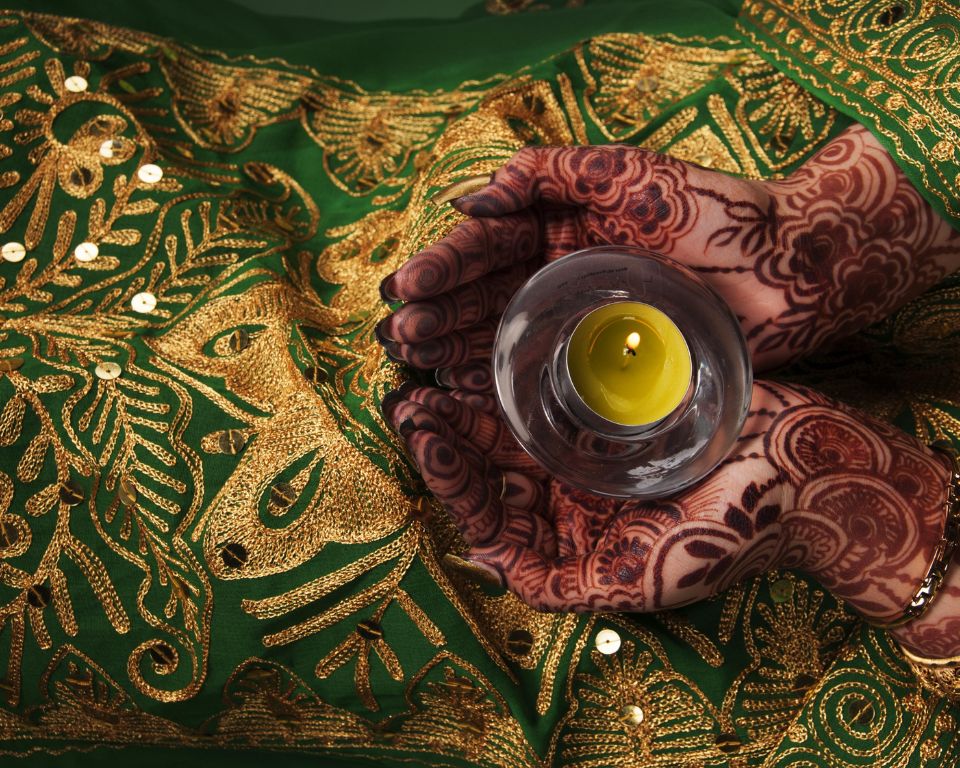Have you ever seen beautiful, intricate designs on someone’s hands or feet? Those lovely patterns are called mehndi.
Mehndi refers to the art of applying henna designs mainly on the skin. The term itself comes from the Arabic word “mehndī,” which describes the practice of using henna leaves to create decorative patterns. Henna, a natural dye, is derived from the leaves of the Lawsonia inermis plant and has been used for centuries in various cultures around the world.
The dark brown color it produces on the skin signifies beauty and joy, making it an essential part of celebrations, particularly in South Asian and Middle Eastern cultures.
Key Takeaways
- Mehndi is the practice of applying henna on the skin to create beautiful designs.
- It has deep cultural significance, especially in weddings and festivals.
- The different types of mehndi designs vary based on culture and individual preferences.
- There is a specific application process for getting mehndi that can be done at home or by professionals.
- Mehndi also has natural benefits for the skin, making it more than just decorative.
Let’s now explore the cultural significance of mehndi.
Cultural Significance
Mehndi carries a rich cultural heritage. It is traditionally associated with joyful occasions such as weddings, festivals, and religious ceremonies.
In many cultures, especially in countries like India, Pakistan, and the Middle East, mehndi is applied to brides before their wedding day.
This practice is believed to bring good luck and prosperity to the couple. Different designs may also symbolize love and connection.
Moreover, the application of mehndi is often a social event. Friends and family gather to celebrate, share stories, and bond while getting their mehndi done together. This aspect not only highlights the importance of mehndi in rituals but also in strengthening relationships.
Types of Mehndi Designs
When it comes to mehndi, the designs are endless. There are traditional patterns, intricate floral motifs, geometric shapes, and even modern designs that reflect personal styles. Here are a few common types of mehndi designs:
- Arabic Mehndi: Known for its bold and large patterns, often featuring floral designs and spirals.
- Indian Mehndi: This style tends to have fine details and is usually quite intricate, covering large areas of the skin.
- Pakistani Mehndi: A blend of Arabic and Indian styles, this often includes elaborate designs with complex detailing.
- Western Mehndi: A more contemporary approach, featuring minimalistic and bold designs.
Each design type has its meaning and significance, making the choice of mehndi a personal reflection of one’s style and culture.
Application Process
The application of mehndi may seem complex, but it can be an enjoyable process. Here’s how it typically goes:
- Preparation: First, the skin must be clean and free from oils to ensure the best results.
- Henna Paste: The henna is mixed to the right consistency and placed inside a cone for easy application.
- Design Application: The mehndi artist, or you, will apply the henna to the skin, creating the desired design.
- Drying: After application, it’s essential to let the mehndi dry completely. This usually takes a couple of hours.
- Aftercare: Once dry, the mehndi should be kept away from water for a few hours to allow the color to deepen.
By following these steps, one can enjoy the delightful experience of applying mehndi, either alone or with friends and family.
Benefits of Mehndi
Mehndi is not just about beauty; it also offers various benefits. Firstly, applying mehndi can have a calming effect on the mind, as the process is often seen as therapeutic.
Moreover, natural henna has cooling properties, making it helpful for soothing skin irritations. Some people even use mehndi for its potential antifungal and antibacterial benefits. This natural form of body art is not only visually appealing but also provides some health advantages.
Conclusion
In conclusion, mehndi is more than just a decorative art; it is a meaningful tradition that connects people and cultures.
Whether it’s for a wedding, a festival, or simply a way to express oneself, mehndi symbolizes beauty, joy, and togetherness.
By embracing this art form, we can appreciate the stories and traditions that come with it and enjoy the delightful experience of mehndi in our lives.
Frequently Asked Questions
1. What ingredients are used in mehndi?
Mehndi is primarily made from henna leaves, which are dried and ground into a fine powder. To create the paste, water, lemon juice, and essential oils like eucalyptus are frequently added to help release the dye.
2. How long does mehndi last on the skin?
Mehndi typically lasts from one to three weeks on the skin, depending on how well it is cared for and factors like skin type and exposure to water.
3. Is mehndi safe for everyone?
Mehndi is generally safe for most people. However, some may experience allergic reactions to the henna paste or certain added ingredients. It’s best to do a patch test before full application.
4. Can I apply mehndi on my own?
Yes, you can definitely apply mehndi by yourself. Many people enjoy doing it as a fun activity. All you need is some practice, patience, and the right tools to create beautiful designs.


